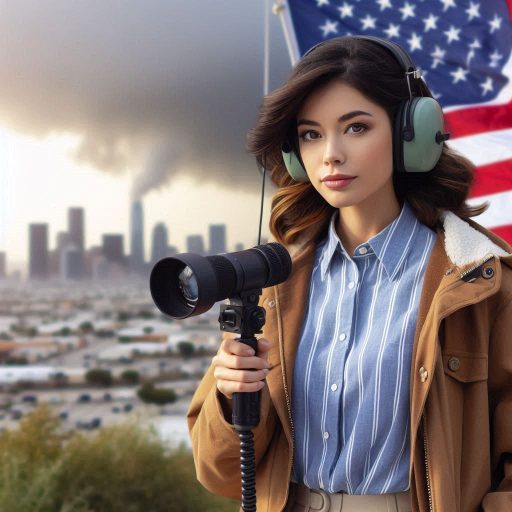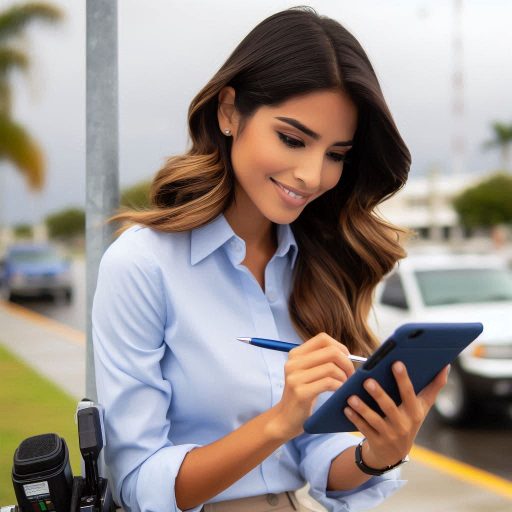Introduction
Meteorologists study atmospheric phenomena to understand and predict weather patterns.
They play a vital role in our daily lives.
Meteorologists rely on advanced technology, including satellite and radar systems, to gather and analyze weather data.
Satellite technology captures images of weather systems from space.
It provides crucial information about cloud cover, temperature, and humidity.
Radar technology sends signals to detect precipitation and storm intensity.
It offers real-time updates on weather conditions and helps track severe weather events.
Both technologies enhance meteorologists‘ ability to make accurate forecasts.
Meteorologists use satellite data to monitor large-scale weather patterns.
They analyze radar data to observe localized weather events.
This integration allows for timely warnings and better preparedness for extreme weather.
For example, meteorologists can predict hurricanes and tornadoes more accurately with these tools.
They share vital information with emergency services and the public.
In general, meteorologists use satellite and radar technology to monitor and predict weather events effectively.
These tools are essential for accurate forecasting and public safety.
Understanding how meteorologists utilize these technologies highlights their importance in addressing climate-related challenges.
Accurate weather predictions save lives and protect property.
Importance of satellite technology
Satellite technology plays a crucial role in modern weather forecasting.
Satellites provide valuable data from regions unreachable by ground-based instruments.
This data helps meteorologists monitor and predict weather patterns with greater accuracy.
The ability to collect information from vast areas of the earth makes satellites indispensable.
They contribute significantly to understanding large-scale weather events such as hurricanes and global climate patterns.
Overview of How Satellites Provide Data
Weather satellites orbit the earth and collect data in real-time.
They use sensors to monitor changes in the atmosphere, oceans, and land surfaces.
Satellites capture images and gather data on temperature, humidity, wind patterns, and cloud formation.
This data is then transmitted back to ground stations, where meteorologists analyze it.
Satellites provide continuous global coverage, which allows meteorologists to track changes as they happen.
This ability to constantly observe the earth‘s atmosphere is critical for accurate forecasting.
Examples of Data Collected from Satellites
Satellites collect a wide range of meteorological data.
They measure sea surface temperatures, monitor cloud movement, and capture detailed images of storm systems.
Satellites also track wind speeds at various altitudes and observe how weather systems evolve over time.
These measurements are crucial for predicting severe weather events like cyclones, tornadoes, and thunderstorms.
Satellite data helps monitor atmospheric changes such as the development of high and low-pressure systems.
It also aids in detecting environmental hazards, including wildfires and volcanic ash clouds.
How Meteorologists Use Satellite Data for Weather Forecasting
Meteorologists use satellite data to forecast weather with greater accuracy.
They analyze satellite images to detect cloud formations, storm systems, and weather fronts.
Satellite data helps predict the movement and intensity of storms, allowing for timely warnings.
By monitoring sea surface temperatures, meteorologists can also forecast hurricane development.
In addition, satellite data helps in tracking droughts and floods, ensuring communities can prepare in advance.
Meteorologists also use this data to create models that simulate future weather patterns.
Satellites provide an advantage in monitoring remote areas such as oceans and polar regions.
These areas are often beyond the reach of traditional weather stations, making satellite observations essential.
In combination with radar technology, satellite data enhances the ability to track weather in real time.
This continuous stream of information improves the accuracy of weather predictions.
Satellite technology, therefore, plays a fundamental role in modern meteorology, providing the critical data needed to protect lives and property.
Satellite technology revolutionized meteorology.
Its ability to collect, transmit, and analyze atmospheric data helps meteorologists predict weather patterns with unparalleled accuracy.
By providing continuous global coverage, satellites have become essential tools for weather forecasting and disaster preparedness.
Importance of Radar Technology
Radar technology is essential for meteorologists to track and predict weather patterns.
It provides real-time data on precipitation, wind speed, and storm development.
Radar helps meteorologists monitor severe weather, ensuring timely warnings and better preparedness.
Its ability to detect storms and track their movements allows for more accurate forecasting.
Radar technology has become a crucial tool in safeguarding communities from the impact of extreme weather events.
Explanation of How Radar Works
Radar works by emitting radio waves that bounce off objects in the atmosphere, like raindrops or hailstones.
The radar system then receives the reflected waves, which provide information about the location and intensity of precipitation.
By measuring the time it takes for the radio waves to return, meteorologists can calculate the distance of a weather system.
Radar data is displayed as images showing rainfall, storm intensity, and movement patterns.
This information helps meteorologists analyze weather conditions and predict storm behavior.
Types of Radar Used by Meteorologists
Meteorologists primarily use two types of radar: Doppler radar and dual-polarization radar.
Doppler radar measures the speed and direction of moving objects, like rain and wind.
It helps meteorologists detect rotating winds within storms, a key indicator of tornado development.
Doppler radar is widely used to monitor thunderstorms and track tornadoes in real time.
Dual-polarization radar, on the other hand, sends out both horizontal and vertical radio waves.
This allows it to detect the size, shape, and type of precipitation, improving the accuracy of forecasts.
It can distinguish between rain, snow, hail, and even airborne debris during a storm.
How Radar Helps Meteorologists Track Severe Weather Events
Radar plays a critical role in tracking severe weather events.
It allows meteorologists to detect thunderstorms, tornadoes, and hurricanes as they develop.
Radar data helps identify storm intensity and potential for damage, enabling timely warnings for at-risk areas.
For example, Doppler radar is instrumental in predicting tornadoes by identifying rotation within thunderstorms.
Radar images also show the path of hurricanes, providing crucial information for evacuation planning.
By tracking rainfall and storm movement, radar helps predict flash floods and monitor their progress.
Meteorologists use radar technology to assess the potential for dangerous weather conditions.
Radar allows them to issue alerts before severe weather strikes, giving people more time to take safety measures.
During hurricanes, radar helps pinpoint landfall locations and storm surge predictions, protecting coastal communities.
Radar systems continuously provide real-time data, enabling meteorologists to adjust forecasts as conditions change.
This real-time monitoring is essential for improving the accuracy of weather warnings.
Radar technology is vital for detecting and tracking severe weather events.
It provides meteorologists with detailed, real-time information on storm development, helping to protect lives and property.
By using radar systems, meteorologists can predict, monitor, and issue timely warnings for extreme weather conditions.
Read: How Climate Change Is Impacting Plant Research
Integration of Satellite and Radar Technology
The integration of satellite and radar technology plays a critical role in modern meteorology.
Both technologies provide complementary data that enhance the accuracy of weather predictions.
Satellite technology offers a broad, global view of atmospheric conditions, while radar provides localized, real-time information.
By combining both, meteorologists gain a comprehensive understanding of weather systems, improving forecasting capabilities.
Advantages of Using Both Technologies Together
Using both satellite and radar technology together offers significant advantages.
Satellites provide high-resolution imagery of cloud cover, temperature, and wind patterns across large areas.
This data helps meteorologists monitor developing storms and detect atmospheric changes.
Radar, in contrast, offers real-time insights into precipitation, storm movement, and wind speed at a local level.
Together, these technologies allow meteorologists to track weather from formation to impact.
This combination improves the precision and timing of forecasts, especially for severe weather events.
Another advantage is the ability to predict long-term and short-term weather conditions.
Satellites can track large-scale climate patterns, while radar focuses on immediate weather activity.
This combination gives meteorologists the tools to make both strategic and immediate forecasts, providing crucial information for different timeframes.
Using satellite and radar data together also improves disaster preparedness, offering both early warnings and ongoing updates during storms.
Case Studies of Successful Weather Predictions Using Satellite and Radar Data
Several case studies highlight the success of using satellite and radar technology together in weather forecasting.
During Hurricane Katrina in 2005, meteorologists relied on satellite imagery to monitor the storm’s development in the Atlantic Ocean.
As the hurricane approached land, radar systems tracked its intensity and path, allowing authorities to issue timely evacuation orders.
This integration of data helped mitigate the storm’s impact and saved lives.
Another example is the use of satellite and radar data in tracking tornadoes across the Midwest.
In 2013, meteorologists used satellite data to identify atmospheric conditions conducive to tornado formation.
Doppler radar then detected rotating winds within thunderstorms, helping predict the precise timing and location of tornadoes.
This combined approach resulted in highly accurate warnings, reducing casualties during severe storms.
How Meteorologists Combine Satellite and Radar Data for Accurate Forecasts
Meteorologists combine satellite and radar data to create more accurate and reliable weather forecasts.
Satellite images show large-scale weather patterns, such as jet streams, pressure systems, and cloud formations.
Radar data offers real-time information on localized weather activity, like precipitation and wind speed.
By integrating these data sets, meteorologists can track how large-scale patterns impact local weather conditions.
For example, meteorologists might use satellite images to detect a developing hurricane.
As the storm moves closer to land, radar helps monitor rainfall and wind speed in real time.
Combining the two technologies provides a more complete picture, allowing for better predictions on storm intensity and timing.
This integration is particularly valuable for predicting severe weather events like tornadoes, hurricanes, and flash floods.
Integrating satellite and radar technology significantly enhances weather forecasting.
These technologies provide complementary data that allow meteorologists to track both global and local weather patterns with precision.
Using them together leads to more accurate predictions, helping to protect lives and property.
Read: Exploring the Different Branches of Geology

Challenges Faced by Meteorologists
Meteorologists face various challenges when forecasting the weather, particularly when relying on satellite and radar technology.
Despite advancements, these technologies have limitations that can affect the accuracy of weather predictions.
Understanding these challenges helps meteorologists refine their methods and improve forecast reliability.
Limitations of Satellite and Radar Technology
One key limitation of satellite technology is its inability to provide continuous, real-time data.
Satellites orbit the Earth, and depending on their position, they may only capture snapshots of weather conditions.
This delay can make it difficult to track rapidly changing weather systems, such as thunderstorms or tornadoes.
Furthermore, cloud cover can obstruct satellite sensors, making it harder to collect accurate information in areas prone to heavy cloud formation.
Radar systems also have limitations.
While radar is excellent for monitoring localized weather patterns, it has a limited range.
Beyond a certain distance, radar signals weaken, leading to less reliable data.
Additionally, radar struggles to penetrate mountainous regions, creating gaps in weather coverage in such areas.
These limitations hinder the ability of meteorologists to gather consistent and reliable data across diverse geographic landscapes.
Factors That Can Affect the Accuracy of Data Collected
Several factors can affect the accuracy of data collected through satellite and radar technology.
Atmospheric conditions, such as humidity and air pressure, can distort radar signals, resulting in inaccurate readings.
For instance, temperature inversions can cause radar beams to bend, leading to false echoes that misrepresent storm intensity or location.
This can create confusion for meteorologists trying to track severe weather events.
Interference from other electronic devices can also impact radar data.
Cellular networks, radio frequencies, and even nearby electronic equipment can disrupt radar signals, causing inaccuracies.
In satellite technology, technical malfunctions or data transmission issues can lead to incomplete or corrupted data, further complicating the forecasting process.
How Meteorologists Work to Overcome These Challenges
Despite these challenges, meteorologists employ several strategies to overcome limitations and improve forecast accuracy.
To address satellite delays, they use multiple satellites that provide continuous coverage, allowing for more frequent data collection.
Newer geostationary satellites also help by providing constant monitoring of specific regions, offering near real-time data.
Meteorologists can also combine satellite data with ground-based observations to fill in any gaps.
In radar technology, meteorologists utilize multiple radar systems to cover larger areas and compensate for range limitations.
Dual-polarization radar, which measures both horizontal and vertical dimensions of precipitation, provides more detailed data on storm structure.
This helps meteorologists identify different types of precipitation and better predict storm severity.
Meteorologists also rely on advanced algorithms and computer models to process radar and satellite data.
These tools help filter out noise and correct for distortions caused by atmospheric conditions or interference.
By integrating data from various sources and using sophisticated modeling techniques, meteorologists can overcome many of the challenges posed by satellite and radar limitations.
While satellite and radar technology have their limitations, meteorologists work tirelessly to improve data accuracy.
By leveraging advanced tools and strategies, they continue to refine weather forecasts, ensuring the best possible predictions despite these challenges.
Read: Top Skills Needed for a Successful Geology Career
Transform Your Career Today
Unlock a personalized career strategy that drives real results. Get tailored advice and a roadmap designed just for you.
Start NowFuture Developments in Satellite and Radar Technology
Advancements in satellite and radar technology promise to revolutionize weather forecasting and meteorological research.
Emerging trends in both areas are set to enhance accuracy and expand capabilities, enabling meteorologists to predict weather events with greater precision and speed.
Advances in Satellite Technology
New satellite technology developments focus on improving resolution and data collection frequency.
Modern satellites feature higher-resolution imaging, which allows meteorologists to observe smaller weather systems and capture finer details.
Additionally, next-generation satellites are designed to capture data at shorter intervals, providing near real-time weather monitoring.
One major advance is the use of CubeSats, which are small, low-cost satellites.
These compact satellites can be deployed in large numbers to provide more comprehensive coverage of the Earth‘s atmosphere.
Unlike traditional satellites, which often focus on specific regions, CubeSats can cover broader areas, filling in data gaps and improving the timeliness of forecasts.
Another breakthrough is the integration of hyperspectral imaging in satellites.
This technology allows for the collection of detailed information about the Earth’s atmosphere by capturing data across multiple wavelengths.
Emerging Trends in Radar Technology
Radar technology is also experiencing significant advancements.
One key trend is the development of phased-array radar systems.
Unlike traditional radar, phased-array radar can scan entire areas almost instantaneously, reducing the time it takes to detect and track severe weather.
This speed is crucial when monitoring fast-moving storms, such as tornadoes or hurricanes.
Another emerging trend is the use of dual-polarization radar, which can send and receive signals in both horizontal and vertical planes.
This technology improves the accuracy of precipitation measurements, helping meteorologists distinguish between rain, snow, hail, or sleet.
As a result, weather predictions become more precise, reducing the likelihood of incorrect forecasts.
Mobile radar systems represent another important advancement.
These portable radar units can be quickly deployed in areas where permanent radar installations are lacking.
Mobile radars are especially useful in remote regions or during disaster situations when infrastructure may be compromised.
Potential Impact on Weather Forecasting and Meteorological Research
The integration of advanced satellite and radar technologies is set to transform weather forecasting.
With higher resolution data, faster processing speeds, and more accurate measurements, meteorologists can make better-informed predictions.
This will enhance early warning systems, helping communities prepare for extreme weather events like hurricanes, floods, and wildfires.
Meteorological research will also benefit from these advancements.
More precise data will allow scientists to study weather patterns in greater detail, improving our understanding of climate change and atmospheric processes.
Additionally, emerging technologies may help researchers identify new trends and anomalies in weather systems, contributing to more effective climate models.
Future developments in satellite and radar technology will significantly improve weather forecasting and meteorological research.
These advances promise more accurate predictions, better early warnings, and a deeper understanding of our planet‘s weather systems.
Read: What Does a Geologist Do? Career Overview and Insights
Ethical considerations in using technology
As technology continues to evolve, ethical considerations in its use are becoming increasingly significant.
When applying advanced tools in fields like meteorology, ensuring that ethical responsibilities are upheld is crucial for maintaining public trust and data integrity.
Discussion on Data Privacy Issues
One of the key ethical concerns in using technology is the issue of data privacy.
In meteorological research, large amounts of data are collected from various sources, including satellites, radar, and even public sensors.
While much of this data is used to predict weather patterns and natural disasters, some may inadvertently include personal information.
It‘s essential for meteorologists and researchers to respect privacy by anonymizing data and using secure methods for collection and storage.
Failing to safeguard personal information could lead to privacy breaches, compromising trust in meteorological institutions.
With the rise of the Internet of Things (IoT), connected devices now play a more prominent role in data collection.
Ethical considerations must account for the fact that individuals may not be aware of their involvement in data gathering processes.
Transparency about how data is used and protecting user privacy is critical to maintaining ethical standards in technological applications.
Ensuring Data Accuracy and Reliability
Another ethical obligation is to ensure data accuracy and reliability.
Meteorologists rely on advanced technologies like satellites, radar, and supercomputers to generate forecasts and predictions.
If this data is inaccurate or improperly interpreted, it could result in false predictions, affecting everything from flight operations to disaster preparedness.
The impact of these errors can be profound, potentially risking lives or causing significant economic losses.
To prevent inaccuracies, data must undergo rigorous validation processes.
Meteorologists should use multiple sources to cross-check and verify data before releasing predictions to the public.
Reliable models and continuous monitoring of the data collection systems help minimize the chance of errors.
It‘s also essential that meteorological researchers acknowledge uncertainties and communicate these clearly to decision-makers and the public.
Balancing Technological Advancements with Ethical Responsibilities
While technology presents new opportunities for improving meteorological research and forecasting, it must be balanced with ethical responsibilities.
Technological advancements should not come at the expense of ethical considerations.
For instance, in the rush to adopt cutting-edge satellite and radar systems, there‘s a risk of over-reliance on automated systems.
Human oversight remains essential to ensure that ethical guidelines are followed in the interpretation and application of data.
Balancing the rapid pace of technological innovation with careful ethical scrutiny is critical.
Ethical concerns around data privacy, accuracy, and the implications of new technology must be addressed proactively.
Researchers, policymakers, and technologists should work together to create guidelines that allow for innovation while safeguarding ethical standards.
The use of technology in meteorology requires constant attention to ethical responsibilities.
Protecting data privacy, ensuring accuracy, and maintaining transparency are essential to sustaining public trust and advancing the field responsibly.
Delve into the Subject: Materials Science Internships: Gaining Experience
Conclusion
Meteorologists depend on satellite and radar technology for accurate weather monitoring and prediction.
These tools enhance our understanding of atmospheric conditions.
Satellites gather critical data on cloud cover, temperature, humidity, and wind patterns from space.
This information helps meteorologists track large weather systems and monitor global climate dynamics.
Radar provides real-time data on precipitation and storm intensity.
By sending signals that bounce off atmospheric particles, radar detects the location and movement of storms.
This capability allows for timely warnings of severe weather events.
Integrating satellite and radar data improves forecasting models and enhances prediction accuracy.
This accuracy is crucial for sectors like agriculture, aviation, and emergency management.
Timely forecasts can mitigate the impact of natural disasters and save lives.
As technology advances, meteorologists can analyze larger datasets more effectively.
This advancement improves preparedness for extreme weather events and climate change.
Ultimately, satellite and radar technology are essential tools in meteorology.
They enable better monitoring and prediction of weather events.
Continued investment in these technologies will strengthen our ability to protect communities from climate-related threats.




